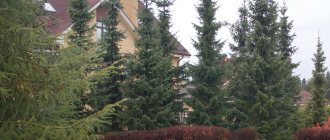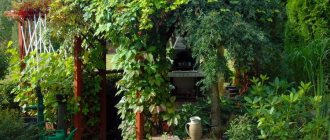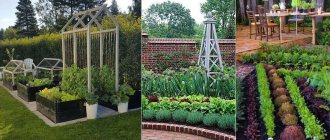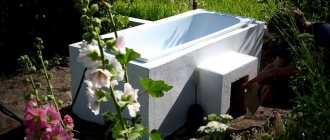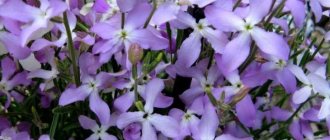Decorating the landscape, arranging green areas in parks, protecting houses and cottages from dust, noise absorption, snow retention, protection from winds, clear territorial demarcation, air purification - and all this is quite possible if you create a dense green wall of decorative bushes and shrubs. But which plants are best for this? The cypress family is one of the most successful options. Find out how to plant a hedge of thuja, which will be distinguished by its extraordinary beauty and rich functionality.
Planting thuja for hedges
A hedge is a fashionable design element of a country house and its surrounding areas.
Boring profile, metal, wood and stone fences can be decorated with a green wall made of bushes. Various types of plants can be used as such a decorative fence. However, it is still better to give preference to voluminous evergreen crops, for example, thuja.
Thuja is an unpretentious evergreen plant. Its main feature is that during the growth process it can be given any shape. It is this fact that determines its suitability for planting as a hedge. In addition to practical properties, thuja also has medicinal properties, like other coniferous plants. The volatile substances released into the atmosphere have antimicrobial properties.
Therefore, by choosing thuja as a fence planting, you will receive not only a functional fence, but also clean and healthy air in your area.
Cone (or pyramid)
If you are new to topiary trimming and are afraid of not being able to cope with the first cutting of your thujas, start with the simplest shape - a cone.
Its main advantage is the simplicity of the frame. As such, wooden slats with a height slightly higher than the bush are used. The main thing in this matter is to distribute the slats evenly around the circumference and connect them using wire or rope exactly above the central conductor of the bush.
Then everything is simple: using scissors, cut the thuja edge by edge, focusing on the stencil.
When the cutting is finished, the sticks are removed and the lower part of the trunk is slightly freed from the branches.
Then, using smaller scissors, trim the shape and adjust the top.
Do not try to shape the thuja into an inverted cone. In this case, the top will shade the lower part of the bush, and the sun simply will not reach there.
Where is it used?
Thuja is a shrub that reaches a height of 20-25 meters, which allows it to be used in almost any landscape design. Depending on the type, thujas are used as decoration for alpine hills, rockeries, artificial and natural reservoirs, fountains, flower beds and alleys. In any case, the strict appearance of the plant and its versatility will carry an aesthetic note.
Varieties and varieties
Thuja is a plant native to warm southern regions. In our climate, varieties such as Brabant, Smaragd, Holmstrap are preferred. These varieties are optimized for harsh conditions and can easily tolerate low temperatures and extreme heat.
“Brabant” is a thuja variety that is characterized by fast growth and frost resistance. The trees reach up to 15 meters in height. It is the above properties that make this variety most suitable for creating a hedge.
“Smaragd” - this variety has a special cone-shaped shape, perfect for both decorative single planting and for hedges.
“Holmstrap” is a low-growing variety of thuja characterized by slow growth. Used as a hedge, but does not require cutting. The maximum height of a plant of this species reaches 2-2.5 meters.
The “Smaragd” and “Brabant” varieties are the most acceptable option for a thuja hedge. Both varieties lend themselves well to molding and grow well. From such “living plasticine” you can create any composition: from a classic fence to fancy figures.
However, it is better to use Smaragd, since the crown of this subspecies grows in width, which allows you to create a fence without gaps - dense thickets create a single wall.
How to plant?
Thuja is propagated by cuttings. However, shrub propagation activities are carried out in specialized nurseries. On store shelves they sell ready-made one-year-old seedlings, completely ready for planting.
A hedge of thuja is laid in spring or autumn. Spacing between Thuja Brabant in a hedge? In order to plant a hedge correctly, you need to follow simple rules:
- the distance between seedlings is 1.5-2 meters. If you plan to make a fence in several tiers, then we make markings where we observe the proportions: the distance between plants is 0.5 meters, and between rows is 1 meter;
- pit depth – 80 cm, size is selected individually depending on the rhizome;
- When planting, be sure to add peat mixture, sand, and fertilizers directly into the hole, regardless of the type of soil;
- It is necessary to bury the seedling so that the root neck is underground.
Trimming time – when to prune?
Any variety of thuja is pruned immediately after planting. It’s correct if you immediately give the plant the desired shape, without waiting for it to grow. In the future, pruning is done in such a way that the thuja slowly grows. To do this, only the apical shoots are cut off to cause tillering. The Brabant variety reacts especially to this. The sides are trimmed to create the desired shape and width of the hedge.
Sanitary pruning in the spring will include the removal of dead branches. And after the hedge has reached the desired height, only formative cutting is carried out.
Thuja begins to be pruned in the spring, after the frosts have ended, and can be done throughout the summer and autumn. The beginning of pruning is determined by the climatic characteristics of the area; in the southern regions, you can begin the procedure already at the end of February.
Trimming in damp rainy weather is undesirable, because at this time the content of pathogenic microorganisms in the air is increased, and after pruning the tree has open wounds and is especially susceptible to disease.
After the past winter, sanitary pruning and removal of branches that died during the winter and were damaged by snow are mandatory. If the tree was wrapped in fabric for the winter, it is necessary to give it time to straighten. A crown that is too thick is thinned out so that the tree feels better in the heat. Forming cutting of branches is carried out after the spring active growth of thujas.
Pruning thuja in autumn
The second optimal period for pruning is at the end of August, when the tree begins to prepare for winter.
Before cutting thuja at the end of summer and beginning of autumn (September), you should pay attention to the condition of the plant: how it survived the summer, how good the green mass is at the bottom of the tree, near the ground. The fast-growing western thuja should give an increase of 30 cm over the summer
Excessively long branches cause harm to the plant in winter, because too much snow will stick to them.
The purpose of autumn pruning of thuja is to prepare the plant for winter. At the end of August, thuja is pruned not only for decorative purposes, but also to protect it from snowfall.
Maintaining the plant in optimal condition depends not only on correct pruning as such, but also on choosing the appropriate period. For coniferous trees it will be significantly different from fruit trees. The reason for this is the physiological characteristics of the family.
Let's consider when to trim thujas:
- In spring, the bud breaking phase usually occurs 10 days after the average daily temperature has strengthened at 10 degrees. The flowering phase begins depending on the region: the first half of May or April, early June. If you remove excess branches before buds open and flower, you increase the risk of stopping the growing season. This technique is used only to save the current dimensions of the tree. To obtain growth, be sure to wait until the thuja fades.
The second optimal period occurs in the autumn, at the end of August, at the beginning of September. The purpose of this event is to prepare the plant for wintering. Particular attention should be paid to long branches that may break off due to snow.
What will you need?
Materials and tools needed for planting a green thuja wall:
- seedlings, as a rule, are packaged in pots in nurseries;
- garden tools (shovel, rake, drill, watering can or irrigation system);
- turf soil;
- compost;
- peat mixture, it can be purchased at any gardening store;
- sand;
- drainage;
- water for irrigation;
- combined mineral fertilizer;
- kraft paper;
- scissors or pruning shears for trimming hedges.
Care
An important role in the survival rate of thuja is played by systematic care, which consists of the following principles:
- Thujas are unpretentious plants, but insufficient watering affects their appearance: the color may fade and the crown may thin out. Young thujas need regular and abundant watering (1-2 times a week), and adult plants cannot do without it, especially in the hot summer.
- After watering, the soil is loosened to a depth of 8-10 cm. To avoid loosening, the soil is mulched with peat or wood chips.
- If fertilizers were applied during planting, they will be needed next time after 2 years.
- To form a fence of the desired profile, trimming is carried out as needed, cutting off no more than a third of the shoot.
- During the first two winters, young plants are protected with covering material: burlap or kraft paper.
At the winter quarters Source redka.com.ua
How to care?
A thuja hedge requires care, despite the fact that the seedlings are unpretentious. In the first year, the rows of shrubs should be weeded regularly. Watering the hedge is essential, especially if the rows are planted in open areas.
For the first two years, plants also require fertilizer. As food, you can use special mixtures that are sold in gardening stores. Planting privet for a hedge? It is recommended to hold such events 2-3 times a year.
As a result, the young trees will become stronger.
Since thuja does not tolerate the scorching sun, especially young shrubs are covered with an awning on hot days and watered by sprinkling. In winter, to avoid freezing of the rhizome, the roots are insulated, and the branches are tied to the trunk so that snowfalls and strong winds do not damage them.
Another important point in caring for thuja is cutting. It is carried out in spring and autumn. The process involves not only the removal of damaged and dead shoots, but also the formation of a crown.
You can clearly see the intricacies of crop pruning in the video.
A hedge made of thuja varieties Brabant and Smaragd is the ideal fence for your country house. Such a fence will protect from dust and dirt, prying eyes and will create a harmonious design that will definitely fit into the overall image of any site, regardless of style.
With proper and regular care, such a fence will delight you for many years.
Niwaki
The method of forming the “niwaki” crown is rooted in Japanese culture. There are 8 main styles, for each of which a specific place in the garden is prescribed:
- "Tekan". It is based on a vertical single trunk, around which a crown is formed in the form of a regular triangle.
- "Sokan." Niwakis of this style are cut on two trunks forked from the root neck.
- "Kotobuki." This is a kind of amulet, since its shape is an image of the Japanese hieroglyph for “happiness”, next to which there must be a traditional stone lantern.
- "Shakan." A single tree trunk is formed at an angle to the surface of the earth. Traditionally, these forms of nivaki are located on the banks of reservoirs.
- "Moegi." The trunk is formed in the form of a sinusoid. As a rule, they are included in garden compositions.
- "Kongai." Crowns formed in this style have a flowing shape. Look good next to rocky walls and slides.
- "Monkaburi". A tree formed in this style traditionally precedes the entrance to the garden: the lower branch should be very long and located horizontally above the entrance.
- "Kyoto". The style originated in the city of the same name in Japan. The peculiarity is that it is formed exclusively on cryptomeria.
In the video below, Andrey But (Osokor nursery) voices the basic principles of the “niwaki” haircut. Having many years of experience in growing plants, the nurseryman uses various methods of forming the crown of plants in his work and willingly shares his knowledge by conducting master classes.
Features of planting thuja along the fence
- About the plant
- Which varieties to choose?
- Distance
- Planting scheme and care
- Ideas
Thuja is an evergreen and unpretentious beauty that is perfect for decorating any garden plot. The tree also acts as a universal fence. Planting thuja along the fence is a simple matter.
The main thing is to decide on the composition and follow the presented diagram step by step.
About the plant
Thuja belongs to the genus of coniferous trees, which make up the cypress family. A plant with soft needles and well-developed branches has a chic appearance and exudes an amazing aroma. Evergreen shrubs can create a hedge up to 15-20 meters high. There are a huge number of design ideas: from a simple fence to original living sculptures.
The tree is easy to cut and is durable. With proper care, thuja grows and develops for more than 50 years. The evergreen beauty also purifies the air from gases and dust, and its amazing aroma gives a person a positive charge for the whole day.
Beautiful and useful!
Which varieties to choose?
To create a hedge of thuja in the country, the varieties “Brabant” and “smaragd” are suitable. These varieties of western thuja have a number of advantages.
- Brabant. A fast-growing, unpretentious plant ideal for hedges. It is distinguished by a massive cone shape with a slope into a column. This variety is known for its high frost resistance and is easy to care for. Brabant is characterized by rapid growth, and in a couple of years the height of the living fence will be 4-5 meters. Frequent trimming in spring and summer will improve the appearance of trees. The needles will become more magnificent and dense.
- Emerald. This variety of thuja has a cone-shaped shape with thick, smooth needles. Like Brabant, the tree is easy to care for and has excellent frost resistance. However, the growth of Thuja Smaragd is quite slow. Therefore, creating a tall hedge will take a lot of time.
In addition to Western varieties, conical varieties of thuja - “columna” and “yellow spiralis” - are suitable for creating an unshaped green hedge. As for miniature low shrubs, “Golden Globe” and “Little Champion” are perfect for a “green fence”. Western varieties can also be planted in groups and in flower beds in combination with thuja plicata.
Fruit bushes
In addition to barberry, there are a number of other popular fruit bushes for sun and shade that do not require special care.
One of the common types is red currant, whose berries on the bush are pleasing to the eye. In addition to red currants, black currants are also grown at dachas near fences in the shade in the neighborhood. Its berries grow in clusters, like the red one. Currant bushes along the fence need to be watered frequently.
Red Ribes
Blackberries and red raspberries can be planted along paths in the shade where there is a border. Fruit bushes look great on large private plots, but if there is little space, then you should not plant them. The blackberries are trimmed because the branches of the bush should not touch the ground.
Raspberries
Viburnum bushes can also be planted near a private fence in the shade, but they need to be watered abundantly. Like blackberries, the viburnum bush is pruned to form a decorative crown and grow shoots of the plant.
Kalina
Distance
A beautiful hedge can be created in the courtyard of a private house or in a country house. According to the law, trees should be planted at a distance of 3-5 meters from the living space and 1 meter from the main fence. As for the formation of a composition of thujas, the distance in the hedges is adapted to the size of adult plants. When creating a hedge of conical and columnar thujas, trees are planted at a distance of 1 linear meter.
Slow-growing Western varieties require a space of 60 cm. Fast-growing folded thujas are planted at a distance of 90 cm. Is planting a hedge one of the best solutions? For a two-row fence it is 2 meters.
In this case, the seedlings are planted in a checkerboard pattern. When choosing the largest varieties of thuja, the plants are placed at a distance of up to 5 meters from each other. The soil can be anything.
Note that an important point when planting seedlings is their condition. To create a proper “green fence”, young, healthy trees with a strong root system are suitable. For group planting, you should not take specimens that are smaller and weaker than the rest.
Otherwise, the hedge will look ridiculous.


